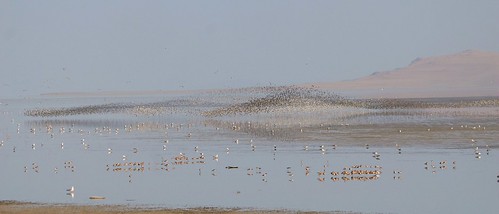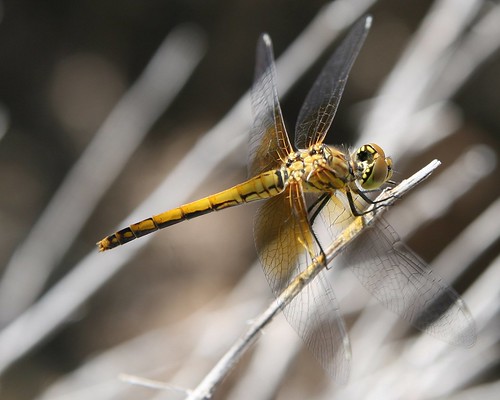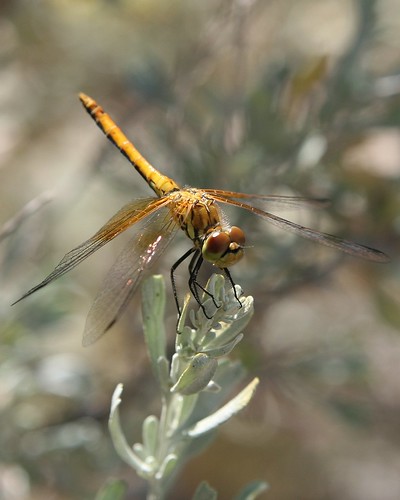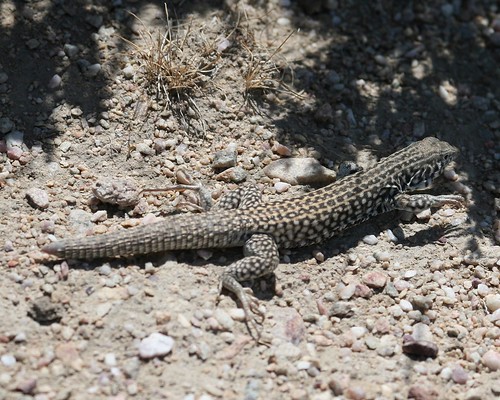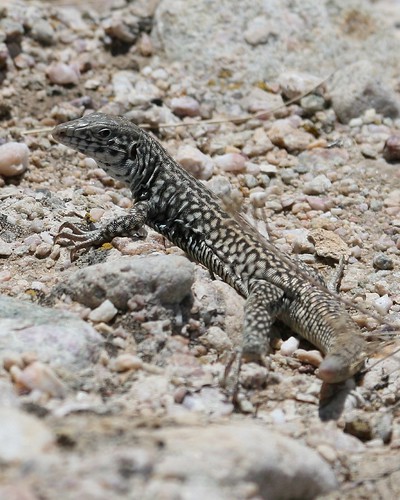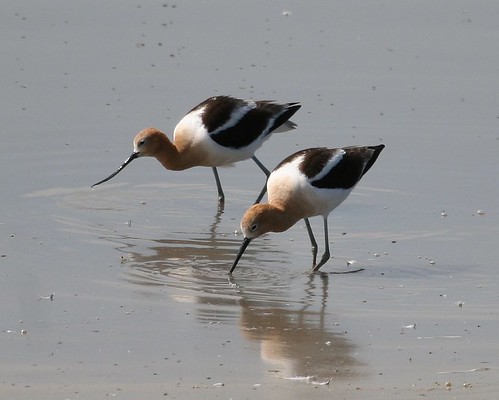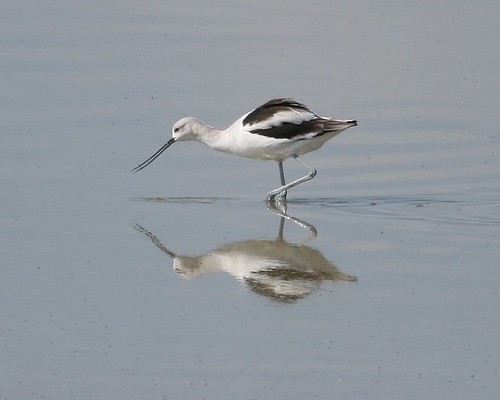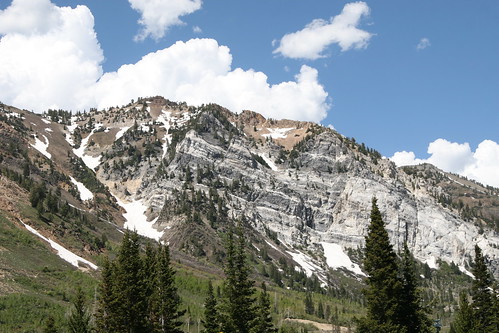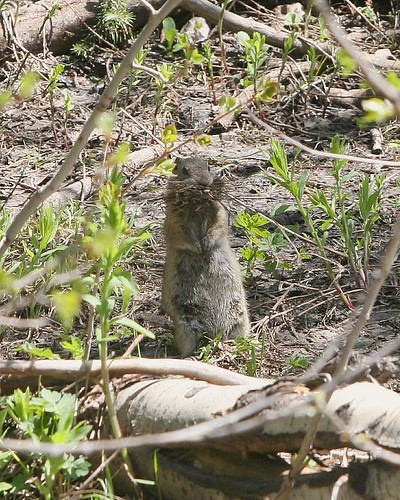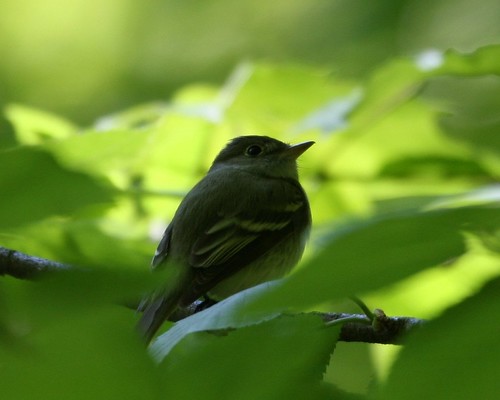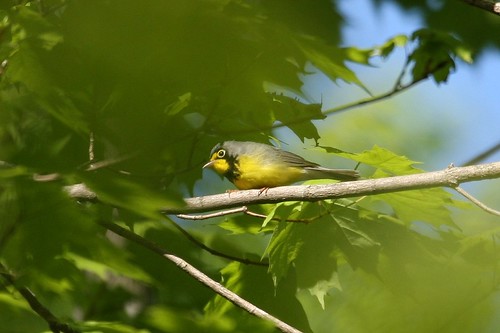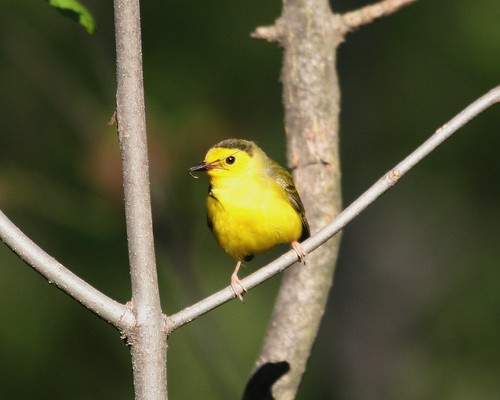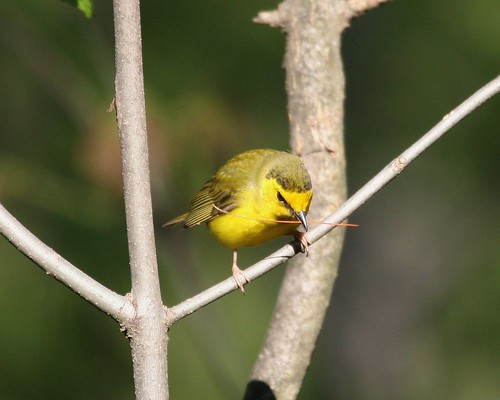Today was a day of no field trips. There was a presentation to attend in the morning and the afternoon, but I skipped out on the afternoon session to just relax. I took the opportunity to ride the ski resort's tram up to Hidden Peak (a two-handed, sweaty, grip-of-death ride up to eleven thousand feet). After the tram ride I then took advantage of some above average wifi bandwidth to enter bird sightings into my account at eBird, and to work through some of the photos I have taken out here in Utah.
After I had entered all my bird sightings, I came to the happy realization that I had seen a lot of species for the first time this week. Some bird watchers like to keep lists of what birds they see, where they saw them and when (I use eBird to track mine). The "master list" is their individual Life List: the list of species they have seen in their life. The number of species on your Life List is a convenient (although misleading) measure of how much bird watching experience you have. I say it is a misleading measure because counting seen bird species does not mean that you are good at finding birds, or at identifying birds, or at understanding birds. Usually you do get better at those things over time, and consequently the number of birds on your Life List will increase, but the opposite is not necessarily true. So, although I am about to reference my Life List, and revel in the fact that it has grown significantly this week, I understand it for what it really means.
When I left home and traveled to Utah, my Life List was at 364 species. People who are not birdwatchers think that number is huge. But when compared to the approximately 1,000 birds that you can see in the United States and Canada (excluding Hawaii), and the approximately 10,000 birds you can see worldwide, my 364 is put firmly in perspective. I knew my 364 would grow this week. This is only the second time I have focused on birdwatching in the western half of the country, so there were going to be easy birds that do not occur anywhere near Virginia that would be first time birds ("lifers") for me. I did not think, however, that I would see as many lifers this week as I have.
As I write this, my Life List has grown to 395! That's right, I have seen 31 new species of bird this week. That is a very large number of new birds. If I manage to see 5 more new species, then I will hit a nice milestone (multiples of 100 are considered relevant in the birding community). I have two more field trips (tomorrow and Sunday) to get those 5 new species before I travel back home. It is entirely possible that I will get those 5 and hit the milestone of 400. I am crossing my fingers!
Lame Internet Access
The hotel I am staying at during the 2008 ABA Convention has free wifi access, but it is unpredictable. I had no access all day yesterday. The other days have had just enough access for me to be able to upload my photos. But the bandwidth is usually too low for me to be able to look at those photos, find the good ones, process those good photos and maybe write a blog post. There is bandwidth, but it is so small at times that I imagine throwing my computer out of my hotel room window might feel good. The last decent bandwidth that I had was a couple days ago when I added three new posts all in the same day. Now I am happy to be able to write this text only post. I suspect I will not get many more posts up until after I return home.
P.S. I have tried publishing this post ten times so far. None of those attempts have made it all the way to the confirmation page yet. Blogger really does not like very low bandwidth.
P.S. I have tried publishing this post ten times so far. None of those attempts have made it all the way to the confirmation page yet. Blogger really does not like very low bandwidth.
Great Salt Lake Flock
To get to Antelope Island, you have to drive across this long causeway that cuts across the Great Salt Lake. The causeway is a great bird watching location, with lots of birds gobbling up the Brine Flies.
A quick word about Brine Flies. There are lots of them at the Great Salt Lake. Lots is an understatement. They are everywhere. If you follow this link, you can read all about Brine Flies and the estimate of a billion Brine Flies during the summer peak at the Great Salt Lake. As annoying as they are, they are an abundant food source for the birds. And, even better...they do not bite. Thank goodness for that.
Back to my post. While I was birding my way across the causeway, I witnessed a flock of birds in the distance. The flock was very coordinated. I am struggling to describe the flock's behavior in words. It was like a ribbon of fabric that was flapping in the wind, except the fabric in this case was made up of hundreds of birds. I took some pictures of that flock as it undulated over the Great Salt Lake. Here is one that I cropped to be very wide, but fairly short, in an attempt to accentuate that flock of birds. I think you can click the picture to get to different (larger) sizes if you want a closer look.
A quick word about Brine Flies. There are lots of them at the Great Salt Lake. Lots is an understatement. They are everywhere. If you follow this link, you can read all about Brine Flies and the estimate of a billion Brine Flies during the summer peak at the Great Salt Lake. As annoying as they are, they are an abundant food source for the birds. And, even better...they do not bite. Thank goodness for that.
Back to my post. While I was birding my way across the causeway, I witnessed a flock of birds in the distance. The flock was very coordinated. I am struggling to describe the flock's behavior in words. It was like a ribbon of fabric that was flapping in the wind, except the fabric in this case was made up of hundreds of birds. I took some pictures of that flock as it undulated over the Great Salt Lake. Here is one that I cropped to be very wide, but fairly short, in an attempt to accentuate that flock of birds. I think you can click the picture to get to different (larger) sizes if you want a closer look.
Western Meadowhawk
I thought this post was going to have another boring generic title. Something like "Dragonfly". But my very first search to identify this dragonfly led me to a site called Wild Utah, specifically the Dragonfly and Damselfly section of that site. I did the brute force approach and clicked on each link on that page so that I could compare the pictures on that site (which are fantastic!) to the pictures that I took. I eventually got to the links for Western Meadowhawk, and in particular the link for a female Western Meadowhawk. This matched my photos very nicely, so I decided my identification search was complete. My two photos were taken on the Buffalo Point Trail on Antelope Island.
Lizard
I have a feeling that many of my blog posts from this week might have boring generic titles. Like this post. The word "lizard" is probably very accurate, but the confidence I have in my identification of the creature I photographed is not very high. I think this is a Great Basin Whiptail. Trying to identify this creature using a very slow Internet connection, creative searches on Google and no field guide was challenging. Coming to the conclusion that the specific creature I photographed is missing most of what is normally a very long tail...well, that was even harder. Both photos were taken while hiking the Buffalo Point Trail on Antelope Island.
American Avocet
Last year, when Tammy and I were in Utah, we visited Antelope Island State Park. Now I am back in Utah again for the ABA Convention, so I returned to Antelope Island yesterday to check out the birds. I posted a picture last year of an American Avocet, so this is not my first photograph of this species. But taking pictures in two different months of the year allows for a nice side-by-side comparison of the breeding and non-breeding plumage of American Avocet. Yesterday's photo (top) shows American Avocet in breeding plumage, with their neck and head having a nice rust color. Last year's September photo shows American Avocet in non-breeding plumage, with the rust color replaced by gray.
Snowbird
Yesterday was a travel day for me. I flew from Virginia out to Salt Lake City. Then I drove to Snowbird, home of this year's ABA Convention. I was fortunate to be able to check-in early, which allowed me to unpack and realize how tired I was. So, other than a short walk around Snowbird, I did not explore very much.
Snowbird is very picturesque. It is located in the Wasatch Mountains, just east of Salt Lake City. Lots of tall conifers, big rocky mountains, and the remains of last winter's snow. Here are a some photos from my short walk, including one of a squirrel who appears to be doing some renovations to his home.
Snowbird is very picturesque. It is located in the Wasatch Mountains, just east of Salt Lake City. Lots of tall conifers, big rocky mountains, and the remains of last winter's snow. Here are a some photos from my short walk, including one of a squirrel who appears to be doing some renovations to his home.
2008 ABA Convention
My spring has been a lot less about bird watching than I would have liked. Other "real life" things seemed to get in the way of my bird watching intentions over and over again. I did get out several times, but I would have liked to have been out far more than I managed. That will all change come Saturday.
This year I am once again attending the American Birding Association annual convention. This is my fourth year. Last year was in Lafayette, Louisiana. This year will be in Snowbird, Utah (in the Wasatch Mountains just east of Salt Lake City). I fly out this Saturday (day after tomorrow!) and do not return until Monday the 30th. Nearly every day in between will be a day outside for photography or birdwatching or both. I am exceptionally lucky to be able to make these trips each year, and even more lucky in that the trip is essentially dedicated to the two hobbies I enjoy the most.
I usually see gobs of birds on these trips, and take gazoodles of photographs. While my usual blogging pace is one post a week (give or take), my pace while in Utah will be much higher (probably a post a day, sometimes more). When I get back from this trip, the blogging pace will return to normal.
This year I am once again attending the American Birding Association annual convention. This is my fourth year. Last year was in Lafayette, Louisiana. This year will be in Snowbird, Utah (in the Wasatch Mountains just east of Salt Lake City). I fly out this Saturday (day after tomorrow!) and do not return until Monday the 30th. Nearly every day in between will be a day outside for photography or birdwatching or both. I am exceptionally lucky to be able to make these trips each year, and even more lucky in that the trip is essentially dedicated to the two hobbies I enjoy the most.
I usually see gobs of birds on these trips, and take gazoodles of photographs. While my usual blogging pace is one post a week (give or take), my pace while in Utah will be much higher (probably a post a day, sometimes more). When I get back from this trip, the blogging pace will return to normal.
Flycatchers
Flycatchers make me nervous. Not nervous like I would be if I were a fly, but nervous like a student who hasn't studied enough and is walking into an exam. Which ones have the wing bars? Which ones *don't* have the wing bars? Is that one's song the "pizza" one, or the "free beer" one? Is this the right habitat for that one?
Okay...I have studied some, so I am not completely in the dark. For example, some songs are really easy to remember, like that of the Eastern Wood-Pewee. And if I am not sure I can put name to song in the field, I will take notes on the song and then identify the bird later by comparing it to songs on the Internet or on CDs that I have purchased.
On my most recent trip to South River Falls (seems like so long ago...but it was only a month back), I listened to and watched several flycatchers. On a couple of occasions I had long looks, and enough time to take some pictures. I remember hearing their song, recognizing them and then taking photographs of them. When I finally got around to scanning through my pictures, however, I was stymied for several moments as I tried to identify the very much non-singing flycatchers in my photographs. I did not realize how much I actually relied on their song to make the identification. I took a few moments, flipped through some field guides, compared to other photographs, and basically re-identified the birds. And I felt pretty silly.
So here are two photographs that I took of a flycatcher on that hike. The first is Acadian Flycatcher. The second is Eastern Wood-Pewee. The second photograph caused me the most trouble in my re-identification efforts, and I still have this tinge of doubt.
Okay...I have studied some, so I am not completely in the dark. For example, some songs are really easy to remember, like that of the Eastern Wood-Pewee. And if I am not sure I can put name to song in the field, I will take notes on the song and then identify the bird later by comparing it to songs on the Internet or on CDs that I have purchased.
On my most recent trip to South River Falls (seems like so long ago...but it was only a month back), I listened to and watched several flycatchers. On a couple of occasions I had long looks, and enough time to take some pictures. I remember hearing their song, recognizing them and then taking photographs of them. When I finally got around to scanning through my pictures, however, I was stymied for several moments as I tried to identify the very much non-singing flycatchers in my photographs. I did not realize how much I actually relied on their song to make the identification. I took a few moments, flipped through some field guides, compared to other photographs, and basically re-identified the birds. And I felt pretty silly.
So here are two photographs that I took of a flycatcher on that hike. The first is Acadian Flycatcher. The second is Eastern Wood-Pewee. The second photograph caused me the most trouble in my re-identification efforts, and I still have this tinge of doubt.
Canada Warbler
Each spring when I visit South River Falls, I always look forward to where the trail comes down to the stream that eventually tumbles over the falls as the South River. It is at this stream that I can reliably find Canada Warbler. Their song gives me my only real chance at finding the bird. They blend in so well with their surroundings that without that song I might look right at the bird and not even notice it.
When I finally do find the bird, I then hope for a photograph. A long lens, patience, and a bird that decides to sit still in the open are all required. I have the lens, and usually have the patience. The other two, I think, are just luck. Last year I managed to get a fuzzy shot of a Canada Warbler. This year was about the same.
When I finally do find the bird, I then hope for a photograph. A long lens, patience, and a bird that decides to sit still in the open are all required. I have the lens, and usually have the patience. The other two, I think, are just luck. Last year I managed to get a fuzzy shot of a Canada Warbler. This year was about the same.
Hooded Warbler
One of my recent hikes on South River Falls Trail (back in May) yielded the usual menagerie of spring migrants, including some that nest in the mountains of Virginia. One species in particular that nests in Shenandoah National Park is Hooded Warbler.
At the very start of my most recent visit, Tammy and I came across a Hooded Warbler that appeared to be gathering nesting material. I took several photos of the bird as it moved about the bushes very close to the ground. It was quite shady in those spots, so I set the ISO on my camera up to 400 in an attempt to compensate for the low light. When the bird suddenly perched in direct sunlight, I had time to snap several pictures that turned out to be above average. Unfortunately I did not have a chance to readjust the ISO back down to 100 before taking these, so they are a bit overexposed. But I will take what I can get :-)
At the very start of my most recent visit, Tammy and I came across a Hooded Warbler that appeared to be gathering nesting material. I took several photos of the bird as it moved about the bushes very close to the ground. It was quite shady in those spots, so I set the ISO on my camera up to 400 in an attempt to compensate for the low light. When the bird suddenly perched in direct sunlight, I had time to snap several pictures that turned out to be above average. Unfortunately I did not have a chance to readjust the ISO back down to 100 before taking these, so they are a bit overexposed. But I will take what I can get :-)
Ovenbird
Walk anywhere in Shenandoah National Park in the springtime and you will hear the singing of an Ovenbird. Their "teacher teacher teacher" song that gets louder as it goes (like someone is turning the volume up) is a sure sign of their presence. That song is easy to hear, but actually spotting the singing bird is a bit more challenging. You would think that their song would make it easier, but for whatever reason, I find them hard to locate visually even when they are singing away.
I had someone recently ask me how the Ovenbird got its name, and I was stumped. It is an odd name. Why go with something simple like Ovenbird when you could have something more eclectic like Scaly-throated Foliage-gleaner?
Okay...I apologize in advance for the detour, but here is where things get complicated. I had picked up my copy of The Birds of Costa Rica in order to find a really complicated bird name that I could contrast with Ovenbird. I flipped through, found Scaly-throated Foliage-gleaner, and was pleased with myself for finding such a mouthful. I wanted to include a link to something meaningful for that name, so I did some searching on Wikipedia. This is where I discovered that the Scaly-throated Foliage-gleaner just happens to be a member of a family of birds that is referenced by the term "ovenbird". Much to my dismay, the specific North American bird whose name is Ovenbird, is not a member of the family of birds (Furnarlidae) whose name is Ovenbird. Sigh.
So, where does the term "ovenbird" derive? Building a nest that is covered, with a side entrance, and has a passing resemblance to a dutch oven was the primary driver. The North American bird called Ovenbird apparently does this. Here are a couple photos of an Ovenbird (the North American kind) that I took on one of my recent South River Falls hikes.
I had someone recently ask me how the Ovenbird got its name, and I was stumped. It is an odd name. Why go with something simple like Ovenbird when you could have something more eclectic like Scaly-throated Foliage-gleaner?
Okay...I apologize in advance for the detour, but here is where things get complicated. I had picked up my copy of The Birds of Costa Rica in order to find a really complicated bird name that I could contrast with Ovenbird. I flipped through, found Scaly-throated Foliage-gleaner, and was pleased with myself for finding such a mouthful. I wanted to include a link to something meaningful for that name, so I did some searching on Wikipedia. This is where I discovered that the Scaly-throated Foliage-gleaner just happens to be a member of a family of birds that is referenced by the term "ovenbird". Much to my dismay, the specific North American bird whose name is Ovenbird, is not a member of the family of birds (Furnarlidae) whose name is Ovenbird. Sigh.
So, where does the term "ovenbird" derive? Building a nest that is covered, with a side entrance, and has a passing resemblance to a dutch oven was the primary driver. The North American bird called Ovenbird apparently does this. Here are a couple photos of an Ovenbird (the North American kind) that I took on one of my recent South River Falls hikes.
Subscribe to:
Posts (Atom)
